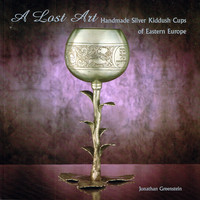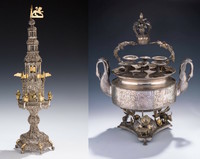The Kiddush cup for the Purim kup
The Young Israel of Woodmere will host “Antique Jewish Ritual Objects From 1700 to Modern Times,” featuring the noted antiques specialist Jonathan Greenstein, author of “A Lost Art: Handmade Silver Kiddush Cups of Eastern Europe,” on March 8 at 8 pm.
With the celebrations of Purim and Pesach just over the horizon, and given the important ritual role played by the Kiddush cup, I chose to devote this week’s essay to Greenstein’s written response to my request for his personal take on this subject.
Over the years Greenstein developed a focus on his Kiddush cup collection both as part of his personal collection and his business service to the public. Sit back now and read the words of a true Judaica expert and specialist as he explains his take on this special Jewish art.
“I have been a collector of Judaica since before my bar mitzvah, developing a focus upon the collection of Kiddush cups.
“Why the Kiddush cup? Well, it seems that the wine cup is symbolically and spiritually rich for the Jews. In the Jewish religious ritual one raises a cup filled with wine to honor G-d. His day of rest is proclaimed, the division between the Sabbath and the rest of the week is recognized, a biblical holiday is ushered in, a Bris Milah is performed, and so by a wedding ritual, the cup of wine is ritually at the center.
“The Kiddush cup is the most basic home ritual object. Even among many non-observant Jews ownership of a Kiddush cup is commonplace, whether for use at a Sabbath meal or most common in such venues, the Passover Seder table where it is the central religious object together with the matzah.
“On Saturday nights we bid farewell to the Sabbath with the Havdalah ceremony in which, as with the Kiddush, we recite a blessing over wine from a special cup.
“In Judaism there is the concept called, “Hiddur Mitzvah,” which literally means ‘’beatification’’ of the ritual. This concept encouraged the use of art to enhance the ritual objects that are used in these ceremonies.
“The most common term for a Jewish religious object is termed, ‘Judaica.’ Judaica can be any object that is used in a Jewish ritual, or can sometimes be a secular item that is decorated with Jewish motifs. Aside from Kiddush cups, the most common objects in Judaica collections are: spice boxes, Chanukah menorahs, candle holders, candelabra, Purim scrolls, and silver used to decorate Torah scrolls, with include crowns and ritual pointers.”
In most every observant Jewish home in our community there can be found many of the ritual objects enumerated above. Their appreciation varies in the interest that each individual invests in terms of their interest in the particulars of these objects. There is a lot of past history in this field of Jewish ritual practice and it behooves us, if we have not done so before, to take a closer look at our own home based ‘’treasure chest’’ of ritual objects and to learn more about them. And that is why Jonathan Greenstein’s craft and expertize is of special value especially at this time of year.
FOR YOUR FURTHER STUDY
The Kehot Publication Society recently released a new and comprehensive English commentary, “Tehillim: Book of Psalms,” featuring, in exquisite English, a commentary based upon sources from the Talmud, Midrash, Kabbalah, as well as from the classic Jewish commentators and Chassidic masters.
Also, for your learning pleasure, please check out “Gedolei Yisroel on the Parashah” by Rabbi Moshe Krieger, a senior rav and magid shiur at Jerusalem’s distinguished Yeshivas Bircas HaTorah, located on Rechov Ohr Hachayim in the Old City.
And lastly, Artscroll recently released an interesting biography of one of the greatest, yet least known, of the gedolim of our time, the beloved Rav Yisrael Zev Gustman, zt”l.
All of these seforim will, iy”H, be the subject of review in the near future. However, do not wait for my take. Buy them all if you wish. They will surely be worth your time.

 46.0°,
Light Drizzle
46.0°,
Light Drizzle 







